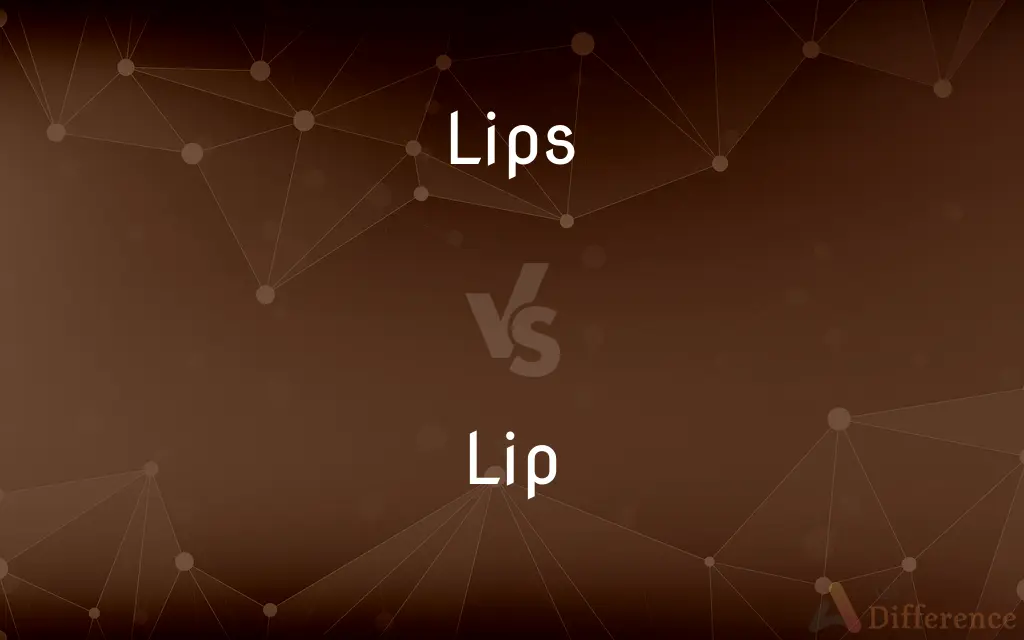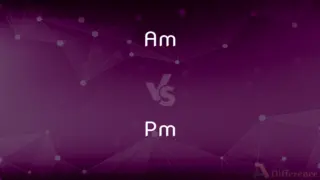Lips vs. Lip — What's the Difference?
By Urooj Arif & Fiza Rafique — Updated on March 24, 2024
Lips refer to the collective outer fleshy parts of the mouth, while a lip is a single one of these parts or an edge of a container.

Difference Between Lips and Lip
Table of Contents
ADVERTISEMENT
Key Differences
Lips, in plural, denote the two fleshy structures surrounding the opening of the mouth, playing key roles in speech, food intake, and expressions. A lip, in singular, can refer to just one of these structures or, in a different context, to the edge or rim of an object, like a cup or crater.
The structure of lips consists of numerous nerve endings and blood vessels, making them sensitive and prone to various colors, whereas a lip, when referring to an object, usually indicates a defined edge designed for a specific purpose, such as pouring.
In human anatomy, lips are essential for articulating sounds and for the tactile sensation, aiding in speech and the consumption of food. Conversely, the term "lip" can also be used metaphorically in phrases like "giving lip," which means to speak back rudely.
Lips are subject to health and cosmetic considerations, with various products aimed at their care and enhancement, such as lip balm and lipstick. The term "lip" in contexts outside human anatomy doesn't carry such associations and is more functional, referring to the boundary or limit of an object.
Lips play a significant role in facial expressions, contributing to non-verbal communication and emotional expression. In contrast, the term "lip" when applied to objects, lacks this dynamic role and is static, serving a practical function.
ADVERTISEMENT
Comparison Chart
Definition
The two fleshy parts forming the outer edges of the mouth.
One part of the lips or the edge of an object.
Function in Anatomy
Involved in speech, eating, and expressions.
Refers to one side of the mouth's edge.
Context
Primarily biological, relating to human or animal anatomy.
Can be biological or refer to the edge of an object.
Care and Products
Targeted by products like lip balm and lipstick.
In non-anatomical contexts, does not relate to cosmetic or health products.
Role in Communication
Play a significant role in non-verbal expressions and emotions.
In anatomical context, part of the structure involved in expressions; otherwise, it refers to an object's edge.
Compare with Definitions
Lips
The outer fleshy edges of the mouth, crucial for speech and expressions.
She applied red lipstick to her lips to enhance their color.
Lip
One of the two parts of the lips or the edge of a container or surface.
The artist drew the lip of the vase with precision.
Lips
Highly sensitive due to numerous nerve endings, responding to touch and temperature.
The cold air made her lips feel dry and chapped.
Lip
Can refer to a specific edge designed for pouring or containment.
She accidentally chipped the lip of her favorite cup.
Lips
Involved in the articulation of many speech sounds, affecting pronunciation.
The movement of her lips was carefully observed by the speech therapist.
Lip
In some sports or activities, "lip" refers to the edge of a ramp or a wave.
The skateboarder launched off the lip of the ramp with impressive skill.
Lips
Subject to various health and cosmetic considerations, like hydration and enhancement.
He used a moisturizing lip balm to protect his lips in winter.
Lip
In speech, "biting one's lip" can indicate hesitation or holding back words.
Biting her lip, she held back the harsh words she wanted to say.
Lips
Expressive components of facial expressions, indicating emotions like happiness or sadness.
His lips curved into a smile, signaling his joy.
Lip
"Giving lip" means to speak impudently or disrespectfully.
The teenager was reprimanded for giving lip to the teacher.
Lips
Either of two fleshy structures that surround the opening of the mouth in humans and other mammals.
Lip
Lips are a visible body part at the mouth of many animals, including humans. Lips are soft, movable, and serve as the opening for food intake and in the articulation of sound and speech.
Lips
In humans, the smooth brownish to reddish border of the lip.
Lip
Either of two fleshy structures that surround the opening of the mouth in humans and other mammals.
Lips
(Anatomy) A labium.
Lip
In humans, the smooth brownish to reddish border of the lip.
Lips
The margin of flesh around a wound.
Lip
(Anatomy) A labium.
Lips
Either of the margins of the aperture of a gastropod shell.
Lip
The margin of flesh around a wound.
Lips
A rim, as of a vessel, bell, or crater.
Lip
Either of the margins of the aperture of a gastropod shell.
Lips
(Botany) One of the two divisions of a bilabiate corolla or calyx, as in the snapdragon, or the modified median petal of an orchid flower.
Lip
A rim, as of a vessel, bell, or crater.
Lips
The tip of a pouring spout, as on a pitcher.
Lip
(Botany) One of the two divisions of a bilabiate corolla or calyx, as in the snapdragon, or the modified median petal of an orchid flower.
Lips
(Slang) Insolent talk.
Lip
The tip of a pouring spout, as on a pitcher.
Lips
To touch the lips to.
Lip
(Slang) Insolent talk.
Lips
To utter.
Lip
To touch the lips to.
Lips
To lap or splash against.
Lip
To utter.
Lips
(Sports) To hit a golf ball so that it touches the edge of (the hole) without dropping in.
Lip
To lap or splash against.
Lips
Plural of lip
Lip
(Sports) To hit a golf ball so that it touches the edge of (the hole) without dropping in.
Lip
(countable) Either of the two fleshy protrusions around the opening of the mouth.
Lip
(countable) A part of the body that resembles a lip, such as the edge of a wound or the labia.
Lip
The projecting rim of an open container; a short open spout.
Lip
Backtalk; verbal impertinence.
Don’t give me any lip!
Lip
The edge of a high spot of land.
Lip
The sharp cutting edge on the end of an auger.
Lip
(botany) One of the two opposite divisions of a labiate corolla.
Lip
(botany) The distinctive petal of the Orchis family.
Lip
(zoology) One of the edges of the aperture of a univalve shell.
Lip
Embouchure: the condition or strength of a wind instrumentalist's lips.
Lip
(of something inanimate) To touch lightly.
Lip
To wash against a surface, lap.
Lip
(intransitive) To rise or flow up to or over the edge of something.
Lip
(transitive) To form the rim, edge or margin of something.
Lip
(transitive) To utter verbally.
Lip
(transitive) To simulate speech by moving the lips without making any sound; to mouth.
Lip
(sports) To make a golf ball hit the lip of the cup, without dropping in.
Lip
To change the sound of (a musical note played on a wind instrument) by moving or tensing the lips.
Lip
One of the two fleshy folds which surround the orifice of the mouth in man and many other animals. In man the lips are organs of speech essential to certain articulations. Hence, by a figure they denote the mouth, or all the organs of speech, and sometimes speech itself.
Thine own lips testify against thee.
Lip
An edge of an opening; a thin projecting part of anything; a kind of short open spout; as, the lip of a vessel.
Lip
The sharp cutting edge on the end of an auger.
Lip
One of the two opposite divisions of a labiate corolla.
Lip
One of the edges of the aperture of a univalve shell.
Lip
Impudent or abusive talk; as, don't give me any of your lip.
Lip
To utter; to speak.
Lip
To clip; to trim.
Lip
Fleshy folds of tissue as those surrounding the mouth
Lip
An impudent or insolent rejoinder;
Don't give me any of your sass
Lip
The top edge of a vessel
Common Curiosities
What are the main functions of lips?
Lips play essential roles in speech, eating, facial expressions, and tactile sensations.
Why are lips sensitive to changes in temperature?
Lips are sensitive because they have a high concentration of nerve endings, making them reactive to temperature and touch.
Can the term "lip" refer to both anatomy and objects?
Yes, "lip" can refer to one of the fleshy edges of the mouth or the edge of an object like a cup or container.
What does "biting one's lip" signify?
"Biting one's lip" can indicate a range of emotions, from nervousness and hesitation to restraint from saying something.
How do lips contribute to facial expressions?
Lips are key in expressing emotions non-verbally, such as smiling or frowning, contributing to overall facial expressions.
What does "giving lip" mean in colloquial language?
"Giving lip" means to talk back or respond rudely or disrespectfully to someone.
What role does the lip play in musical instruments?
In wind instruments, the lip's tension and position can significantly affect sound production and pitch control.
Can the term "lip" be used in sports terminology?
Yes, in sports or activities like skateboarding or surfing, "lip" can refer to the edge of a ramp or the crest of a wave.
What factors can affect the health and appearance of lips?
Factors include hydration, weather conditions, lifestyle habits, and the use of certain products.
How does lip care differ from other skincare routines?
Lip care often involves products specifically designed for hydration and protection, like lip balms or moisturizers, due to the lips' sensitivity.
Can lips undergo medical or cosmetic procedures?
Yes, lips can be enhanced or altered through cosmetic procedures like fillers or medical treatments for conditions like cold sores.
Are lips considered an organ?
While not an organ in the traditional sense, lips are a significant part of the body's integumentary system, contributing to various functions.
Why do lips appear different in color compared to other skin areas?
Lips have a thinner layer of skin and more visible blood vessels, contributing to their distinctive color.
Is the lip structure different in animals compared to humans?
Yes, lip structure can vary significantly across different animals, adapted to their feeding habits, environment, and communication needs.
How do lips aid in the consumption of food?
Lips help in manipulating food intake, sealing the mouth for chewing, and are sensitive to texture and temperature, aiding in the sensory experience of eating.
Share Your Discovery

Previous Comparison
AM vs. PM
Next Comparison
Off vs. OnAuthor Spotlight
Written by
Urooj ArifUrooj is a skilled content writer at Ask Difference, known for her exceptional ability to simplify complex topics into engaging and informative content. With a passion for research and a flair for clear, concise writing, she consistently delivers articles that resonate with our diverse audience.
Co-written by
Fiza RafiqueFiza Rafique is a skilled content writer at AskDifference.com, where she meticulously refines and enhances written pieces. Drawing from her vast editorial expertise, Fiza ensures clarity, accuracy, and precision in every article. Passionate about language, she continually seeks to elevate the quality of content for readers worldwide.











































